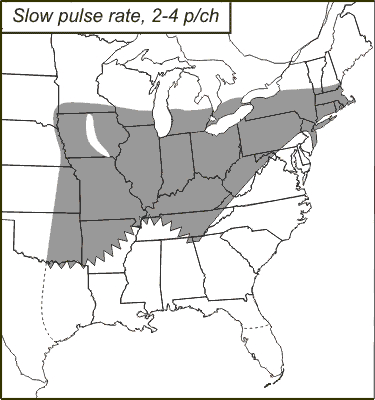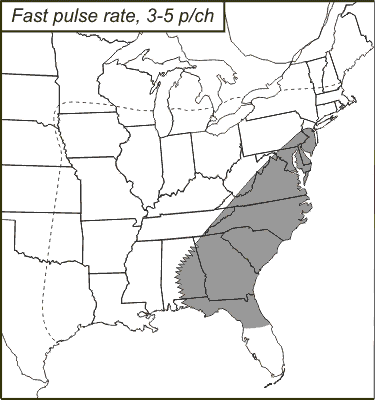|
Song :
|
The onomatopoeic rendition of the songs of northern populations of this species (ka-ty-did) is the source of the most widely applied common name for all members of the family Tettigoniidae. However, the songs of this species vary from locality to locality more than in any other katydid (see maps). In most cases, the song is a regular repetition of a multi-pulse phrase at about 1 s intervals. Neighboring individuals often alternate their phrases with the combined tempo being noticeably quicker than that of a solitary singer. In northern populations the pulse rate within each phrase is slow (ca. 8 per s), and the most frequent numbers of pulses per phrase are three and two. This permits the song to be rendered "Ka-ty-did, she-didn't, she-did." Alternating individuals sound as though they are arguing about whether Katy did or didn't. The southeastern populations, instead of drawling as might seem appropriate, quicken their pulse rate to about 12 per s and increase the number of pulses per phrase to three, four, or five. The phrase rate remains about the same. In the southwestern portion of its range, the common true katydid sings mostly one- and two-pulse phrases. Finally, populations in a narrow north-south band through central Iowa differ from populations to the east and west in having 8-15 pulses per phrase (instead of 2 or 3). The pulse rate remains the same (ca. 8 per s).
|
|
Identification:
|
Length 39-50 mm. A leaf-green, deliberate-moving katydid—as befits a near-flightless species living in treetops. Length of pronotum approximately equal to its rear width; side of pronotum deeper than wide.
|
|
Similar species:
|
Lea floridensis occurs in palmettos, scrubby vegetation, or undergrowth; side of pronotum is wider than deep; the pulses in its song are produced at a rate so fast as to make them difficult to distinguish.
|
|
Habitat:
|
Crowns of deciduous trees in forests, woodlots, and yards.
|
|
Season:
|
June (Fla.) or July (N. Car., Ill.) to October; n. Fla. data.
|
|
Remarks:
|
Common true katydids vary geographically not only in song but also in structure of the male cerci and subgenital plate. Treating all variants as populations of a single species accords with the observation that individuals of intermediate characteristics occur where populations of contrasting types come in contact. Such individuals are evidence of matings and gene flow between populations. The best studied contact zone is between northern and southeastern song types along the Appalachian Mountains. RD Alexander and KC Shaw drove back and forth across the zone at night listening to hundreds of thousands of individuals and tape recording hundreds (Alexander 1968). Sometimes the two song types were kept apart by natural or humanmade ecological barriers, but when they came in contact there was generally a zone of intermediates varying in width "from a few yards to more than a hundred miles."
|
|
More information:
|
Subfamily Pseudophyllinae.
|
|
References:
|
Balsbaugh 1988;
North & Shaw 1979;
Shaw 1968,
1975;
Shaw & Carlson 1969;
Weissmann & Leatherman 1992.
|
|
Nomenclature:
|
OSF (Orthoptera Species File Online).
|
























